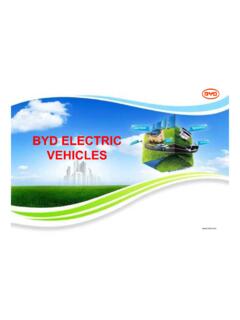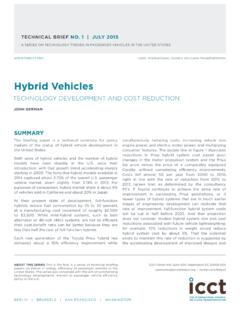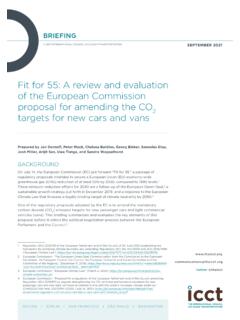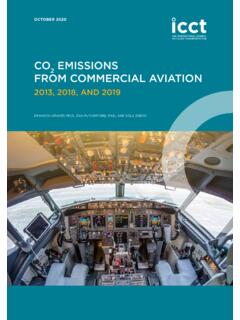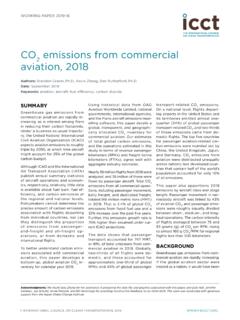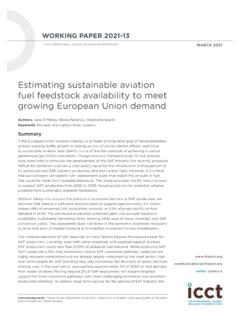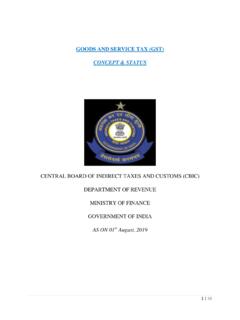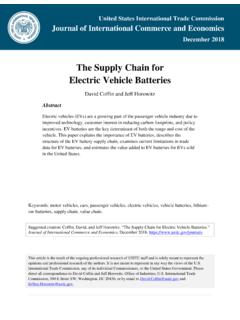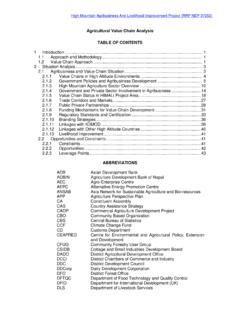Transcription of Fact Sheet: Gasoline vs. Diesel
1 Gasoline VS. DIESELCOMPARING CO2 EMISSION LEVELS OF A MODERN MEDIUM SIZE CAR MODEL UNDER LABORATORY AND ON-ROAD TESTING CONDITIONSBACKGROUNDIn Europe, Diesel engines were promoted as a clean and efficient vehicle technology that would play a key role in reducing carbon dioxide (CO2) emissions in the transport sector. No other region in the world embraced Diesel technology like Europe: in 2016, more than 60% of global Diesel car sales were in the European Union (EU).However, in the aftermath of the Dieselgate scandal, there has been a decrease in Diesel car resale values and a significant drop in Diesel market shares. Registrations of new Diesel vehicles in the EU decreased from a peak of 55% in 2011 to 44% in 2017.
2 The release of a new generation of Gasoline engines for Europe s most popular passenger car, the Volkswagen Golf, in late 2017 provided an opportunity to compare modern Gasoline and Diesel engines side by side, and to determine their respective CO2 emission levels under laboratory and on-road driving VW Golfs were selected for testing, one Diesel (TDI) and one Gasoline (TSI) version. The key characteristics of both vehicles are summarized in Table 1. Both vehicles are rental cars that were type approved according to the Euro 6 emission standard and following the New European Driving Cycle (NEDC) procedure. Both vehicles came to the market prior to the introduction of the Worldwide harmonized Light vehicles Test Procedure (WLTP) and the EU s Real Driving Emissions (RDE) not-to-exceed limits for nitrogen oxide (NOx).
3 FACT SHEET: 2019 BEIJING | BERLIN | BRUSSELS | SAN FRANCISCO | WASHINGTONT able 1. Key characteristics of the two test Golf TDI ( Diesel )VW Golf TSI ( Gasoline )Model year20162018 Emission standardEuro 6bEuro TDI Blue Motion Technology, 110 TSI ACT Blue Motion, 96 kWTransmissionDual clutch, 6 gearsDual clutch, 7 gearsTrim levelComfortlineComfortlineMass of tested vehicle1,420 kg1,340 kg0 80 km/h [s] 100 km/h [s] speed [km/h]214210CO2 (in NEDC)117 g/km113 g/kmList price (in Dec 2017)29,475 Euro26,075 EuroFACT SHEET Gasoline VERSUS Diesel : COMPARING CO2 EMISSION LEVELS2 The TDI is of model year 2016, while the TSI is of model year 2018.
4 However, key characteristics and, in particular, the type approval CO2 emission level did not change significantly between model years 2016 and 2018, thereby allowing for a direct comparison between the two vehicles. Two versions of the new liter Gasoline engine are offered in the Golf TSI, one with 96 kW engine power and the other with 110 kW. Taking into account that both Gasoline versions have virtually identical type approval CO2 emission levels, we selected the 96 kW version as it offers a broader range of CO2 reduction technologies which were of interest for this vehicle testing project. Both vehicles were tested under controlled laboratory conditions on a chassis dynamometer, as well as on-road using Portable Emissions Measurements System (PEMS) FINDINGSThe key findings of the tests are summarized in Figure 1 and described confirmed the Gasoline TSI emitted lower CO2 levels than the TDI, under laboratory conditions.
5 The official NEDC type-approval CO2 values are 117 g/km for the Golf TDI and 113 g/km for the Golf TSI. Following the NEDC test procedure, the values measured were 124 g/km (+6%) for the TDI and 109 g/km (-4%) for the TSI. Testing both vehicles according to the conditions of the new WLTP resulted in higher CO2 emission levels, at 139 g/km for the TDI and 126 g/km for the TSI. As a result, the WLTP vs. NEDC ratio determined was for the TDI and for the TSI. Lower CO2 emissions were observed for the TSI in cold and warm started test cycles despite the TSI s rapid catalyst heat-up strategy, which reduces air pollutant levels but at the same time increases fuel consumption and CO2 emission on-road testing, CO2 levels of the Gasoline TSI were found to be lower than of the TDI.
6 Depending on the route composition, CO2 values ranged from 148 g/km to 163 g/km (26-39% above NEDC type-approval) for the TDI and 140 g/km to 157 g/km (24-39% above NEDC type-approval) for the TSI. Even when taking into account the results of a driving dynamicity analysis, similar or lower CO2 emissions are expected for the Gasoline vehicle under real-world driving experience confirms the Gasoline TSI emits similar or lower CO2 emissions as the Diesel TDI. Comparing the real-world test results to consumer self-reported values, the CO2 levels measured on Routes 1 and 2 are almost exactly in line with the average consumer s experience (-3% to zero deviation for the TDI, +1 to +5% deviation for the TSI).
7 The consumer-reported values confirm the test results, with the Gasoline version 113117109124126139 4%+6%+12%+19%151158157163140148+34%+35%+ 39%+39%+24%+26%162150162+33%+38%Type ApprovalLaboratory TestsaReal World Driving TestsbSpritmonitorcNEDCNEDCWLTPR oute 1 Route 2 Route 3 ConsumerAverage050100150 Golf TDIGolf TSI (96 kW)Golf TSI (110 kW)n/an/an/an=1n=1n=1n=2n=2n=2n=4n=2n=1n =2n=25n=28n=113 CO2 in g/kmFigure 1: CO2 levels of the Golf TDI ( Diesel ) and Golf TSI ( Gasoline ). Comparison of test results with declared type approval values (left-hand side) and Spritmonitor consumer reported numbers (right-hand side). The error bars show the minimum to maximum range of results if multiple tests were performed.
8 The number of tests is shown at the bottom of each bar. The ratio of CO2 emission level vs type approval value is shown above each bar. aThe tests shown were performed at 23 C with cold engine at test start. bThe graph shows the real-world CO2 emissions as measured, not corrected for effects of small differences in driving style or ambient temperature. When taking these effects into account, a similar relationship between the CO2 levels of Gasoline vs. Diesel is expected. cThe bars reflect the average reported CO2 emissions for n different International Council on Clean Transportation is an independent nonprofit organization founded to provide first-rate, unbiased research and technical analysis to environmental INTERNATIONAL COUNCIL ON CLEAN TRANSPORTATIONBEIJING | BERLIN | BRUSSELS | SAN FRANCISCO | WASHINGTONFACT SHEET Gasoline VERSUS Diesel : COMPARING CO2 EMISSION LEVELSC ontact: Peter Mock, +49 30 847129-102, less CO2 than the Diesel version of the VW Golf.
9 Even for the 110 kW version of the Golf TSI, which has a higher driving performance than the Golf TDI and deploys less CO2 saving technologies than the 96 kW Gasoline vehicle, reported CO2 emissions are at the same level as for the Diesel IMPLICATIONSThe results of this vehicle testing project clearly indicate that for the popular lower-medium segment and below, accounting for about 55% of EU market share, a modern Gasoline vehicle can have the same or even lower CO2 emissions than a comparable Diesel version. This finding holds true not only for laboratory testing but also for on-road measurements under real-world driving cars tend to have lower volumetric fuel consumption figures than comparable Gasoline vehicles.
10 However, the benefit in terms of CO2 emissions is significantly lower, as the combustion of 1 liter of Diesel fuel releases approximately 13% more CO2 than for the same amount of Gasoline fuel. Diesel engines require fuel-intensive NOx reduction technologies and are heavier than their Gasoline counterparts, which further reduces the alleged CO2 benefit of Diesel cars. Diesel cars also typically are equipped with more powerful engines and have a higher real-world CO2 emissions gap than Gasoline cars. Furthermore, Diesel engines are inherently more expensive to manufacture than Gasoline engines. In the case of the two tested VW Golf versions, the December 2017 list price of the Diesel vehicle was about 3,400 Euro higher than for the Gasoline many European countries, taxes on Diesel fuel remain significantly lower than on Gasoline .

